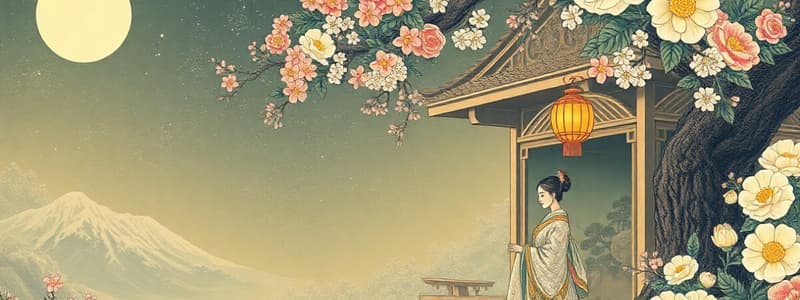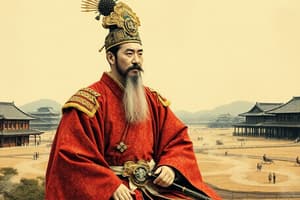Podcast
Questions and Answers
What significant change did Toyotomi Hideyoshi implement regarding slavery?
What significant change did Toyotomi Hideyoshi implement regarding slavery?
- He allowed slaves to purchase their freedom.
- He enforced harsher penalties for slave owners.
- He set laws freeing the majority of slaves. (correct)
- He encouraged the use of slaves in military campaigns.
Which period in Japan is known for its isolation policies, particularly the Sakoku system?
Which period in Japan is known for its isolation policies, particularly the Sakoku system?
- Taisho Period
- Reiwa Period
- Edo Period (correct)
- Meiji Restoration Period
What significant military action occurred during the Showa period?
What significant military action occurred during the Showa period?
- The Meiji Restoration
- The establishment of the National Diet
- The atomic bombing of Hiroshima and Nagasaki (correct)
- The invasion of Korea
What is the structure of Japan's political system described as?
What is the structure of Japan's political system described as?
Which period is characterized by prolonged economic stagnation and the challenges of an aging population?
Which period is characterized by prolonged economic stagnation and the challenges of an aging population?
What significant change occurred during the Yayoi period in Japanese history?
What significant change occurred during the Yayoi period in Japanese history?
Which clan played a significant role during the Asuka period by marrying into the imperial family?
Which clan played a significant role during the Asuka period by marrying into the imperial family?
What was the main religious influence that was officially introduced to Japan during the Asuka period?
What was the main religious influence that was officially introduced to Japan during the Asuka period?
What distinguished the Kofun period in Japanese history?
What distinguished the Kofun period in Japanese history?
Which religion significantly influenced Japanese lifestyle and thought during the Nara period?
Which religion significantly influenced Japanese lifestyle and thought during the Nara period?
During which period was the capital moved to Kyoto?
During which period was the capital moved to Kyoto?
Who was the first shogun of Japan?
Who was the first shogun of Japan?
What term is used to describe the Age of Warring States in Japanese history?
What term is used to describe the Age of Warring States in Japanese history?
Flashcards
Jomon Period
Jomon Period
Early Japanese period characterized by pottery and hunter-gatherer lifestyle.
Yayoi Period
Yayoi Period
Japanese period marked by rice farming, metalworking, and introduction of Shinto beliefs.
Yamato Period
Yamato Period
Period where the Yamato clan unified Japan and built keyhole-shaped tombs.
Asuka Period
Asuka Period
Signup and view all the flashcards
Nara Period
Nara Period
Signup and view all the flashcards
Heian Period
Heian Period
Signup and view all the flashcards
Kamakura Shogunate
Kamakura Shogunate
Signup and view all the flashcards
Sengoku Jidai
Sengoku Jidai
Signup and view all the flashcards
Azuchi-Momoyama period
Azuchi-Momoyama period
Signup and view all the flashcards
Edo Period
Edo Period
Signup and view all the flashcards
Meiji Restoration
Meiji Restoration
Signup and view all the flashcards
Japanese Political system
Japanese Political system
Signup and view all the flashcards
Showa Period
Showa Period
Signup and view all the flashcards
Study Notes
History of Japan
- Study of change over time, covering all aspects of human society (economic, culture)
- Documentation of the human past
Japanese History
- Jomon Period:
- Pottery creation
- Gathering and fishing lifestyle
- Yayoi Period:
- Agricultural advancements (rice farming)
- Metalworking (bronze and iron)
- Belief in Amaterasu (sun goddess)
- Chinese historical texts (Records of Wei) as earliest records of Japan, part of larger Records of the Three Kingdoms
- Japan referred to as "Wa" in Chinese texts
- Differences in body features and attire due to migrations from Korea (around 300 AD)
Kofun Period
- Keyhole-shaped tombs (burial mounds) for the Yamato rulers
- Increased influence of Buddhism
- Capital moved to Nara
Asuka Period
- First empire established
- Chinese influence on writing systems (Kanji) and government
- Japanese name changed from "wa" to "Nihon"
Yamato Period
- Yamato clan unified Japan
- Introduction of Buddhism from Korea
Kamakura Period
- Kamakura Shogunate established
- Minamoto no Yoritomo became first shogun (military dictator)
Muromachi Period
- Ashikaga Takauji overthrowed Kamakura Shogunate
- Rise of Oda Nobunaga (Azuchi Castle) and Toyotomi Hideyoshi (Osaka Castle)
Azuchi–Momoyama Period
- Unification of Japan
- Development of firearms
- Oda and Toyotomi were powerful leaders.
Reiwa Period (2019-Present)
- Recent emperor is Naruhito
- Constitutional monarchy established in 1947
Japanese Political System
- Emperor at the top
- National Diet (legislative branch)
- Cabinet (executive branch)
- Judiciary (judicial branch)
Edo Period
- Tokugawa Shogunate established
- Isolationist policies (sakoku)
- Period of peace and prosperity (Pax Tokugawa)
Meiji Restoration
- Restoration period
- Significant change
Taisho Period
- Significant period
Showa Period
- Pre-war: Militarism, expansion
- Post-war: Recovery and transformation
Heisei Period (1989-2019)
- Economic stagnation (Lost Decade)
- Aging population and declining birth rate
- Natural disasters
Studying That Suits You
Use AI to generate personalized quizzes and flashcards to suit your learning preferences.





